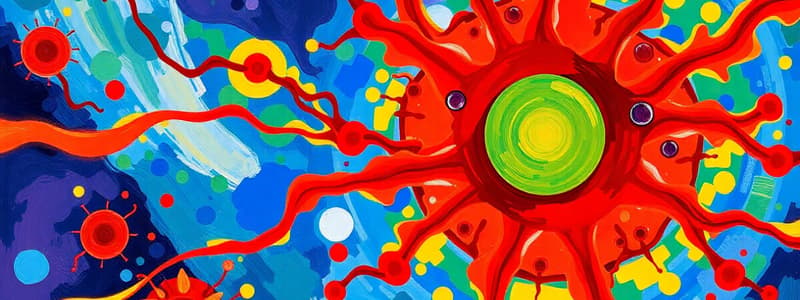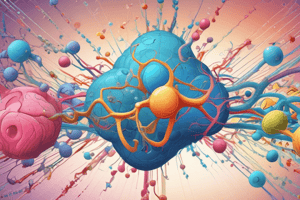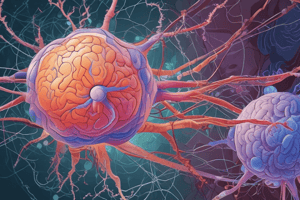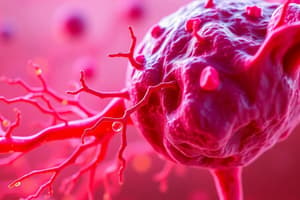Podcast
Questions and Answers
What is the primary mechanism by which a cell distinguishes between different messengers?
What is the primary mechanism by which a cell distinguishes between different messengers?
- The presence of specific receptors that bind to messengers (correct)
- The chemical properties of the messenger itself
- The concentration of the messenger in the cell
- The rate of diffusion of the messenger across the cell membrane
What is the main function of signal transduction pathways?
What is the main function of signal transduction pathways?
- To degrade existing proteins
- To transport molecules across the cell membrane
- To amplify the cellular response to an external signal (correct)
- To synthesize new proteins
Which of the following is an example of a cascade effect in signal transduction?
Which of the following is an example of a cascade effect in signal transduction?
- The activation of a G-protein
- The breakdown of glycogen by the liver in response to epinephrine (correct)
- The binding of a ligand to a receptor
- The synthesis of a new protein
Which of the following is NOT a characteristic of the binding of a ligand to its receptor?
Which of the following is NOT a characteristic of the binding of a ligand to its receptor?
What is the role of G-proteins in signal transduction pathways?
What is the role of G-proteins in signal transduction pathways?
How does ligand binding activate a G-protein?
How does ligand binding activate a G-protein?
What is the main difference between G-protein linked receptors and protein kinase linked receptors?
What is the main difference between G-protein linked receptors and protein kinase linked receptors?
Which of the following statements about G-protein linked receptors is TRUE?
Which of the following statements about G-protein linked receptors is TRUE?
What is the primary function of the G protein in signal transduction?
What is the primary function of the G protein in signal transduction?
What is the role of GTP in the activation of the G protein?
What is the role of GTP in the activation of the G protein?
What is the immediate consequence of the ligand binding to the G protein-linked receptor?
What is the immediate consequence of the ligand binding to the G protein-linked receptor?
Which of the following statements is TRUE about the Gα subunit?
Which of the following statements is TRUE about the Gα subunit?
What process is responsible for the termination of the G protein signaling pathway?
What process is responsible for the termination of the G protein signaling pathway?
What is the main intracellular target of cAMP?
What is the main intracellular target of cAMP?
What is the role of phosphorylation in the G protein-linked signaling pathway?
What is the role of phosphorylation in the G protein-linked signaling pathway?
Which of the following best describes the relationship between the G protein and the G protein-linked receptor?
Which of the following best describes the relationship between the G protein and the G protein-linked receptor?
What is the primary difference between endocrine and paracrine signaling?
What is the primary difference between endocrine and paracrine signaling?
A signal that is produced and acts within the same cell is called a(n):
A signal that is produced and acts within the same cell is called a(n):
Which of the following describes the role of a receptor in cell signaling?
Which of the following describes the role of a receptor in cell signaling?
What is a second messenger in cell signaling?
What is a second messenger in cell signaling?
Which of the following factors influences a cell's response to a signaling molecule?
Which of the following factors influences a cell's response to a signaling molecule?
How does cholera toxin affect cell signaling?
How does cholera toxin affect cell signaling?
Which statement describes the process of signal transduction?
Which statement describes the process of signal transduction?
What is the role of G proteins in signal transduction?
What is the role of G proteins in signal transduction?
What is the function of adenylyl cyclase in the cAMP signaling pathway?
What is the function of adenylyl cyclase in the cAMP signaling pathway?
What is the direct effect of GTP binding to the α subunit of a G protein?
What is the direct effect of GTP binding to the α subunit of a G protein?
Which of the following statements accurately describes the role of cAMP in skeletal muscle and liver cells?
Which of the following statements accurately describes the role of cAMP in skeletal muscle and liver cells?
What happens to cAMP levels when a ligand binds to its receptor and activates the G protein Gs?
What happens to cAMP levels when a ligand binds to its receptor and activates the G protein Gs?
Which of the following mechanisms can elevate cAMP levels in cells?
Which of the following mechanisms can elevate cAMP levels in cells?
What is the effect of the cholera toxin on G protein signaling?
What is the effect of the cholera toxin on G protein signaling?
How do methylxanthines, such as caffeine and theophylline, affect cAMP levels?
How do methylxanthines, such as caffeine and theophylline, affect cAMP levels?
In which of the following situations would cAMP levels be expected to remain high?
In which of the following situations would cAMP levels be expected to remain high?
Flashcards
Signal Transduction
Signal Transduction
The process through which cells translate receptor-ligand interactions into cellular responses.
Hormones
Hormones
Chemical messengers that act at a distance from their site of production.
Local Mediators
Local Mediators
Signals released by cells that act on nearby cells or tissues.
Paracrine Signals
Paracrine Signals
Signup and view all the flashcards
Autocrine Signals
Autocrine Signals
Signup and view all the flashcards
Ligand
Ligand
Signup and view all the flashcards
Second Messengers
Second Messengers
Signup and view all the flashcards
G Proteins
G Proteins
Signup and view all the flashcards
Ligand Binding
Ligand Binding
Signup and view all the flashcards
Amplification
Amplification
Signup and view all the flashcards
Epinephrine Response
Epinephrine Response
Signup and view all the flashcards
Receptor Classifications
Receptor Classifications
Signup and view all the flashcards
G-Protein Linked Receptors
G-Protein Linked Receptors
Signup and view all the flashcards
Conformational Change
Conformational Change
Signup and view all the flashcards
GTP and GDP States
GTP and GDP States
Signup and view all the flashcards
G protein-linked receptor
G protein-linked receptor
Signup and view all the flashcards
GDP and GTP
GDP and GTP
Signup and view all the flashcards
Receptor-G protein complex
Receptor-G protein complex
Signup and view all the flashcards
cAMP
cAMP
Signup and view all the flashcards
PKA
PKA
Signup and view all the flashcards
G protein deactivation
G protein deactivation
Signup and view all the flashcards
Adenylyl Cyclase
Adenylyl Cyclase
Signup and view all the flashcards
Role of Gsα
Role of Gsα
Signup and view all the flashcards
Phosphodiesterase
Phosphodiesterase
Signup and view all the flashcards
Effects of cAMP
Effects of cAMP
Signup and view all the flashcards
Cholera Toxin
Cholera Toxin
Signup and view all the flashcards
cAMP Accumulation
cAMP Accumulation
Signup and view all the flashcards
Study Notes
Signal Transduction Mechanisms: Messengers & Receptors
- Cells have the ability to detect and respond to chemical signals in their environment.
- Cells communicate through displaying surface molecules recognized by receptors on other cells.
- Cells also release chemical signals detected by other cells, which may be close or distant.
Classification of Signaling Molecules
- Signaling molecules are categorized by the distance between production and target tissue.
- Endocrine signals (e.g., hormones): act at a distance from the production site.
- Paracrine signals: act at short distances on nearby tissues (e.g., growth factors). Autocrine signals: act on the same cell that produced them.
General Flow of Information During Cell Signaling
- Ligand (primary messenger) binds to a receptor on a cell surface.
- This binding triggers a signal transduction pathway.
- Signal transduction generates second messengers within the cell.
- Second messengers lead to cellular responses (e.g., changes in gene expression).
Ligand-Receptor Binding
- Ligands bind to receptors through non-covalent bonds.
- This is similar to enzyme-substrate interactions.
- The specific binding style allows cells to distinguish between different chemical signals.
Signal Transduction Pathways
- Amplify the cellular response to external signals.
- For example, breakdown of glycogen by the liver in response to epinephrine.
- A cascade effect is used, a single molecule initiating a chain reaction with a significant impact (e.g., millions of glucose-1-phosphate molecules from one epinephrine molecule).
Receptor Categories
- Ligand-gated channels (transport across cellular membranes).
- Intracellular receptors
- Plasma membrane receptors.
G-Protein-Linked Receptors
- Key receptor type involved in numerous signaling pathways.
- Ligand binding changes receptor conformation, initiating G protein activation, a crucial aspect in this process.
- G proteins are a type of molecular switch, either active (GTP-bound) or inactive (GDP-bound), determining whether the signal continues.
- The activity of G proteins is tightly regulated; once GTP is hydrolyzed the protein reverts to an inactive state with GDP bound, halting the signal.
cAMP as a Second Messenger
- cAMP is an important second messenger used by a class of G-proteins.
- cAMP is synthesized from ATP by adenylyl cyclase in the membrane (which requires activation by the relevant G protein).
- The enzyme is inactive until the relevant G protein’s activated subunit binds to it.
- A ligand binding to the receptor causes GDP release and consequent acquisition of GTP on the relevant G protein subunit.
- This causes the subunit to detach from the receptor and bind to adenylyl cyclase, which causes the production of cAMP.
- cAMP can generate a variety of cellular effects depending on cell type, such as glycogen breakdown, strengthening heart contraction, or inhibiting smooth muscle contraction.
Disruption of G Protein Signaling and Diseases
- Certain bacteria (e.g., Vibrio cholerae and Bordetella pertussis) use toxins that disrupt G protein signaling.
- Cholera toxin modifies the G protein Gs preventing its inactivation, which leads to high levels of cAMP and excessive fluid secretion.
- Pertussis toxin inactivates a different G protein (Gi) involved in inhibiting adenylyl cyclase, disrupting normal cellular regulation.
Studying That Suits You
Use AI to generate personalized quizzes and flashcards to suit your learning preferences.




